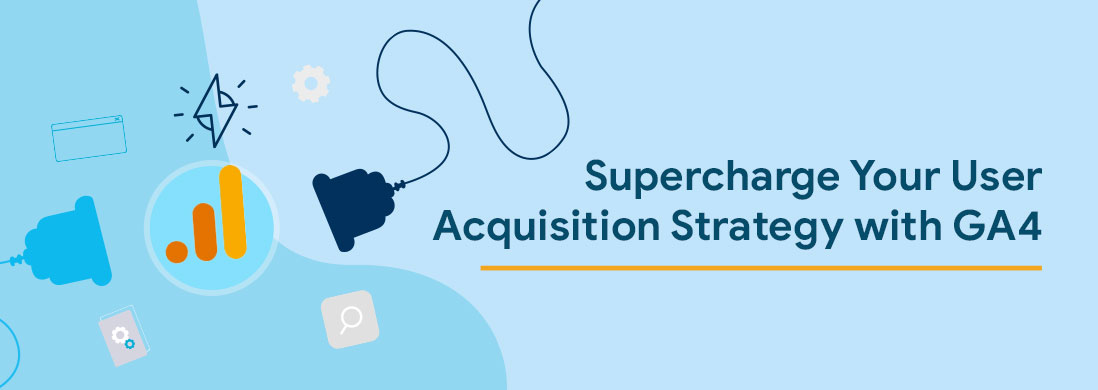GA4 is the latest version of the popular analytics platform, Google Analytics. With machine learning at its core, GA4 offers amazing features through which businesses and marketers can gain comprehensive insights about their web and app users.
We are planning to unlock the power of GA4 and understand how It is helpful to optimize business strategies for acquisition, engagement, and conversions and also showcase the exact difference between Google Analytics(GA4) User Acquisition v/s Traffic Acquisition reports.
How to leverage Acquisition reports in GA?
The acquisition is the first phase of the user’s lifecycle and is considered to be the most crucial stage of the lifecycle. The most challenging and critical stage of any business is to drive more traffic to the website. In GA4, acquisition reports are divided into four categories:
1. Google Analytics(GA4) Overview Report –
Overview reports provide a comprehensive and detailed overview of user behaviour and traffic acquisition. These reports are instrumental in gaining a deeper understanding of how users reach a website and their level of engagement.
By linking Google Ads or Search Console with GA4 property, users can further enhance their analysis by accessing additional acquisition reports in addition to the default one.
These additional reports offer valuable insights and visualizations that aid in comprehending the various channels through which users are acquired and how they interact with the website.
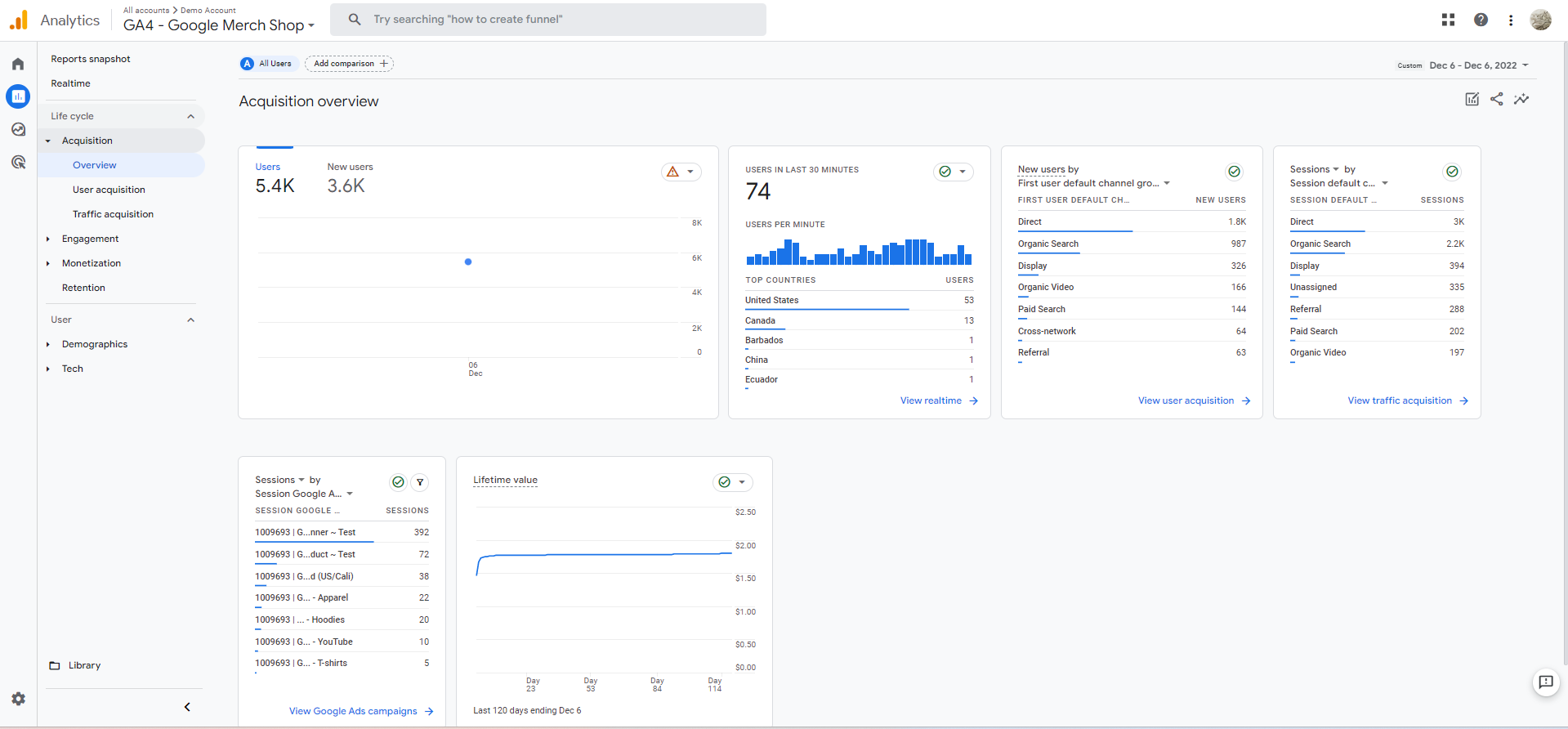
2. Google Analytics(GA4) User Acquisition Report –
The user acquisition report provides a comprehensive overview of how new users are accessing a website or app. By default, the report is organized based on the first-user default channel group, which can be further customized using first-user source and first-user medium dimensions.
The default channel grouping categorizes traffic sources based on predefined rules, allowing users to analyze their data in a more organized manner. Across various Analytics reports, data is presented according to this default channel grouping, which includes commonly recognized traffic sources such as Paid Search and Direct access.
The User Acquisition report serves as a highly valuable tool for gaining profound insights into the initial sources that drive user acquisition for a website or app.
It provides answers to critical questions such as
- How are new users discovering the website for the first time?
- What is the level of user engagement with the site?
- Which campaigns are performing the best or low in terms of acquiring new users?
Furthermore, this report also sheds light on the number of conversions achieved by new users and the total revenue generated by them. By leveraging the data and insights from the User Acquisition report, businesses can optimize their marketing strategies and make informed decisions to enhance user acquisition, engagement, and overall revenue.
The User Acquisition report offers users a wealth of invaluable insights regarding the sources that drive user acquisition, enabling them to optimize their marketing strategies effectively.
This report primarily focuses on the initial traffic source that directs users to the website or app. It serves as an exceptionally informative resource for answering key questions such as:
- How do new users discover the website or app for the first time?
- What are the patterns and extent of new user engagement with the website or app?
- Which campaigns demonstrate the highest and lowest effectiveness in acquiring new users?
- How many conversions are attributed to new users?
- What is the total revenue generated by new users?
By leveraging the comprehensive data and insights derived from the User Acquisition report, businesses can make informed decisions and refine their marketing strategies to maximize user acquisition, enhance user engagement, and ultimately drive higher revenue.
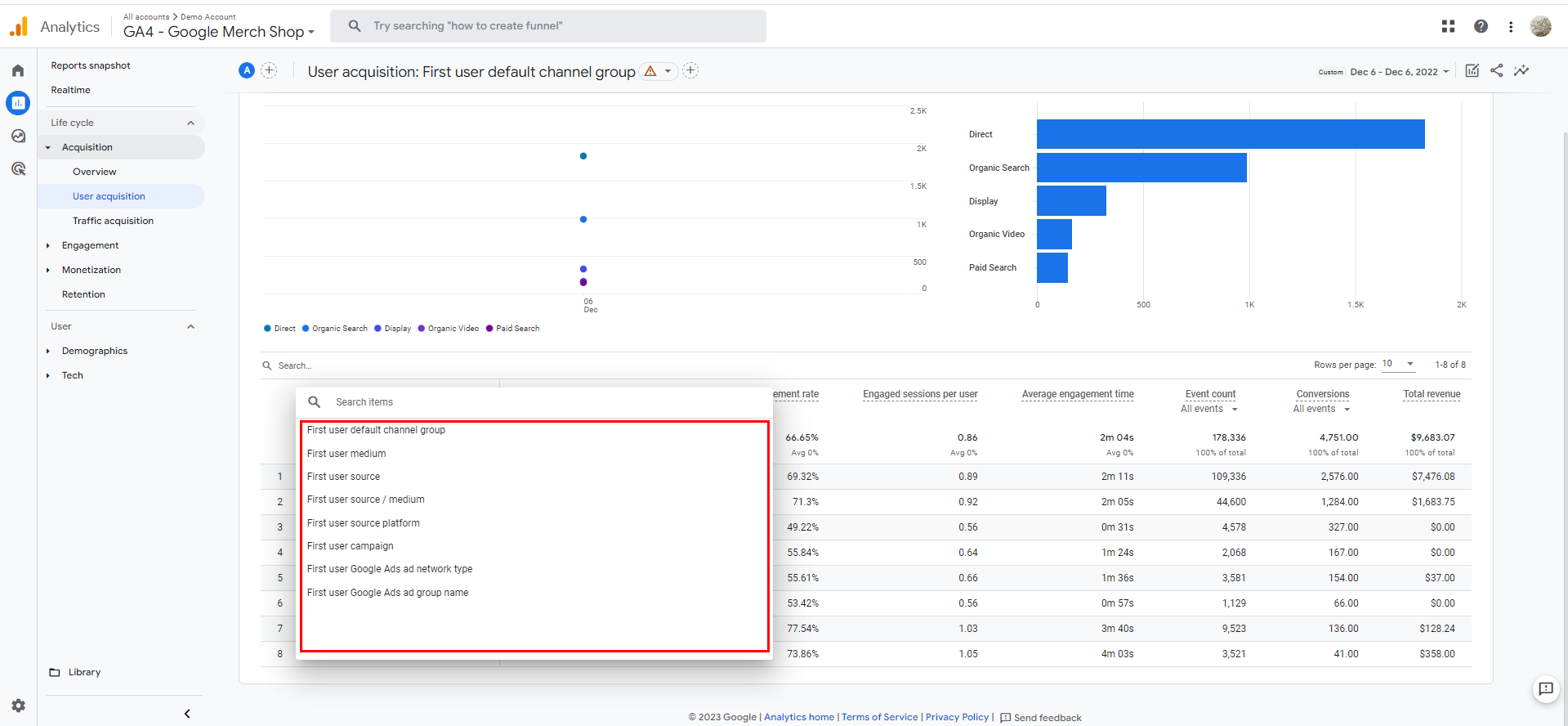
The user-acquisition report uses the first-click attribution model. It gives all credit for the conversion to the first-clicked ad and corresponding keyword. For any user, the value of this dimension will remain the same. For example, A user is initiating his first session with a Paid Search and further sessions with Organic Search, Direct Visits, etc. For this user, the first user default channel will always remain as Paid Search. The metrics that are visible in this report are only for new users for the selected date range.
3. Google Analytics(GA4)Traffic Acquisition Report –
The Traffic Acquisition report provides a comprehensive analysis of how traffic is being directed to a website or app. By default, the primary dimension of this report is the session default channel group, which can be further customized by incorporating other session dimensions.
The main focus of this report is to examine the traffic sources that initiate user sessions on the website or app. This report proves to be highly valuable in gaining insights into the following key aspects:
- How are users initiating their sessions on the website or app?
- How are users engaging with the website or app across different data sources and with varying patterns of traffic?
- Which campaigns are performing the best or the worst in terms of user engagement?
- What is the overall engagement rate of all users?
- What is the total revenue generated by all users?
Leveraging the Traffic Acquisition report enables businesses to make data-driven decisions to enhance user experience, increase revenue, and achieve their desired goals.
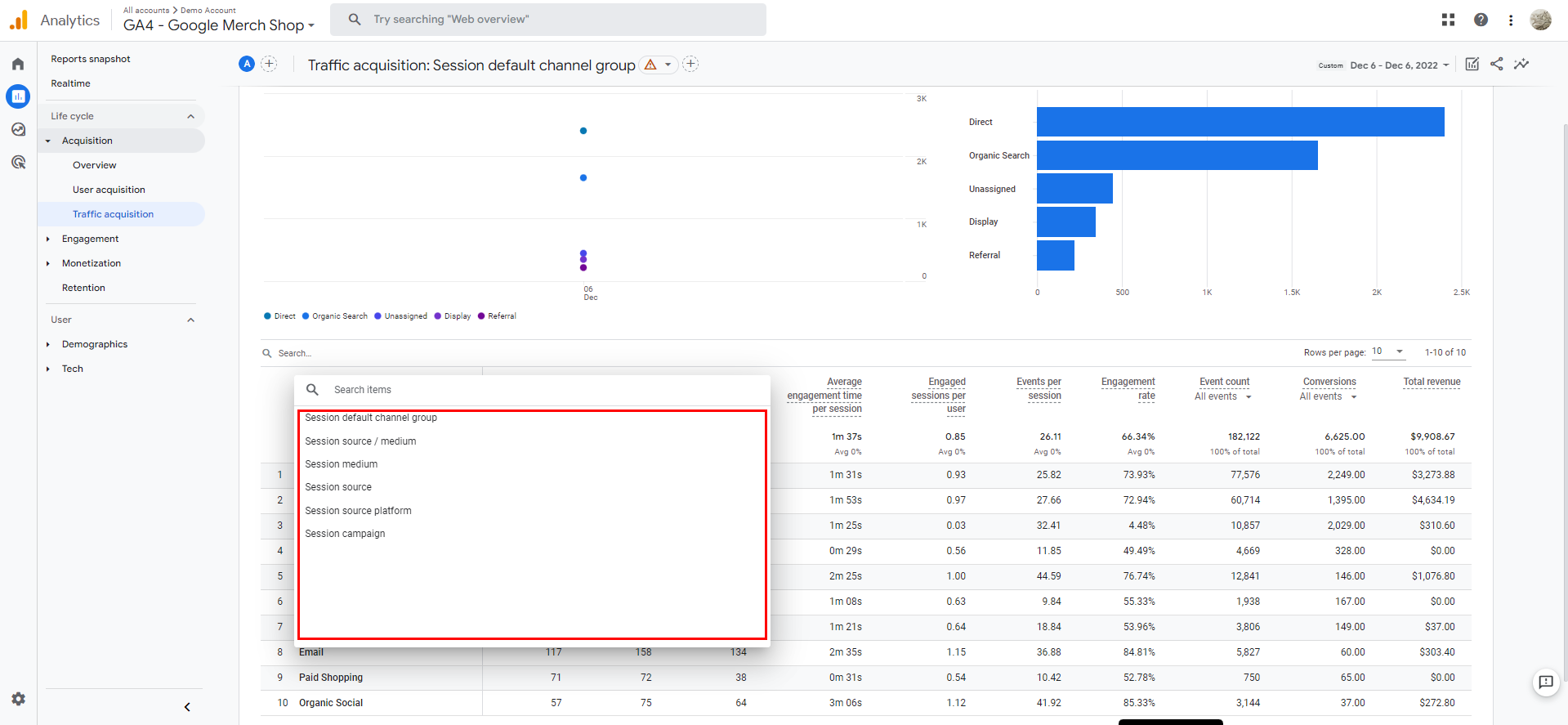
The traffic acquisition report uses the last-click attribution model. It gives all credit for the conversion to the last-clicked ad and the corresponding keyword. For any user, the value of this dimension will be session-scoped.
For example, A user is initiating his first session with a Paid Search and the second session with an Organic Search. For this user, sessions will be attributed to both channels accordingly. The report will be populated only for users who visited the website for the selected date range.
The conversions under this report will be attributed to the sources with which the session was initiated. The same calculation applies to other metrics as well. For the given example, If the user is performing a conversion in the second session, the report will look like this:
| Session default channel group | Users | Sessions | Conversions |
| Paid Search | 1 | 1 | 0 |
| Organic Search | 1 | 1 | 1 |
4. Google Analytics(GA4) Google Ads campaigns report –
This report shows you how your Google ads are performing and how your Google ad campaigns are driving traffic and conversions. This report will get populated if Google ads are linked with GA4 property or with the help of proper UTM tagging.
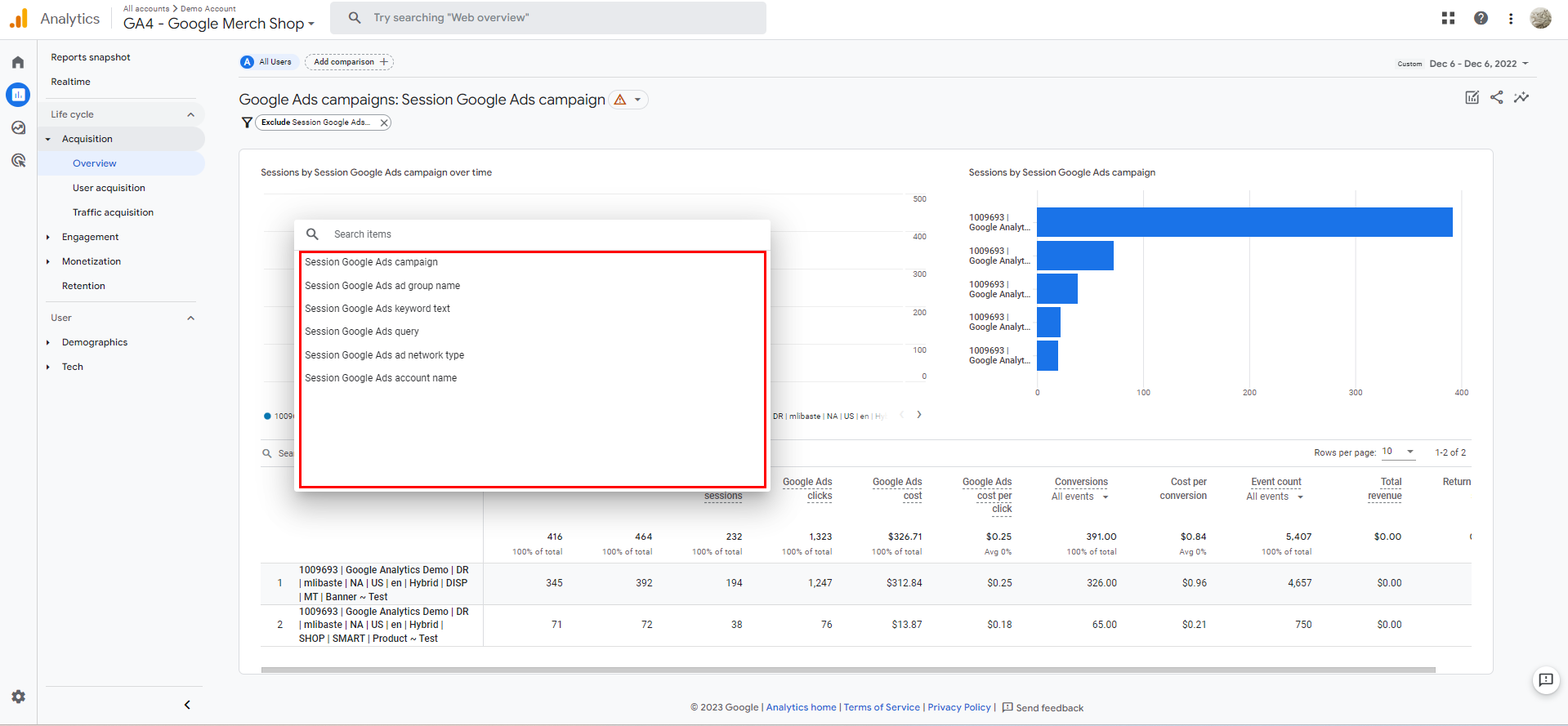
If this report is not visible under the acquisition report, the same can be added with the help of the library – An editor or Admin role is a pre-requisite.
This report includes dimensions and metrics based on Google Ad campaigns, and for some of them, dimensions like Google Ads Clicks, Google Ads cost, and Google Ads cost per click, linking Google Ads with GA4 is a pre-requisite.
How do these reports help you to improve your acquisition strategy?
GA4’s acquisition reports offer valuable insights that enable data-driven decision-making and optimization of acquisition strategies. These reports provide answers to critical questions and facilitate corrective actions in the following areas:
a) Traffic Sources:
By analyzing these reports, you can gain a comprehensive understanding of the channels and campaigns that are driving traffic to your website. For instance, if you’re running ad campaigns to acquire new users, you can determine which campaigns are performing better and make informed decisions accordingly.
b) Cost vs Conversions:
These reports help you calculate the return on investment (ROI) of your app and web campaigns, allowing you to allocate your resources effectively. If certain campaigns are underperforming, you can make necessary adjustments to your campaign strategies.
c) SEO Improvements:
Analyzing organic user data helps identify the performance of landing pages and keywords. This information assists in making timely and appropriate decisions to improve SEO strategies and enhance organic traffic.
d) Targeted Campaigns:
By combining insights from acquisition reports with GA4 demographics and interest data, you can easily target relevant audiences. This approach facilitates the acquisition of interested users to your website, resulting in improved engagement and conversions.
What is the difference between Google Analytics (GA4) User Acquisition v/s Traffic Acquisition?
| Feature | User Acquisition | Traffic Acquisition |
|---|---|---|
| 1). Primary Focus | How new users discover the website/app | How traffic initiates user sessions |
| 2). Key Questions Answered | a). Source of new user discovery | a). Source of session initiation |
| b). New user engagement level | b). User engagement across sources | |
| c). Performance of campaigns for new users | c). Performance of campaigns for engagement | |
| d). Conversions from new users | d). Overall user engagement rate | |
| e). Revenue from new users | e). Total revenue from all users | |
| 3). Attribution Model | First-click attribution | Last-click attribution |
| 4). Channel Grouping | First-user default channel group | Session default channel group |
| 5). Customization Options | First-user source and medium dimensions | Session dimensions |
| 6). Value Scope | Remains constant per user | Session-scoped for each user |
| 7). Conversion Attribution | Attributed to first-clicked ad/keyword | Attributed to last-clicked ad/keyword |
| 8). Example Scenario | The user’s first session is always the basis | Sessions attributed to different channels |
| 9). Metrics Visibility | Only for new users in the selected date range | For all users in the selected date range |
Conclusion:
In conclusion, GA4 empowers businesses to focus on high-performing channels and enables precise audience targeting. It provides an abundance of data about user acquisition and engagement. Additionally, GA4’s customization options allow you to add dimensions and metrics based on specific business requirements, providing flexibility and tailored insights. Stay tuned for the upcoming parts of this series, where we will delve into the analysis of user engagement using GA4’s engagement reports.

